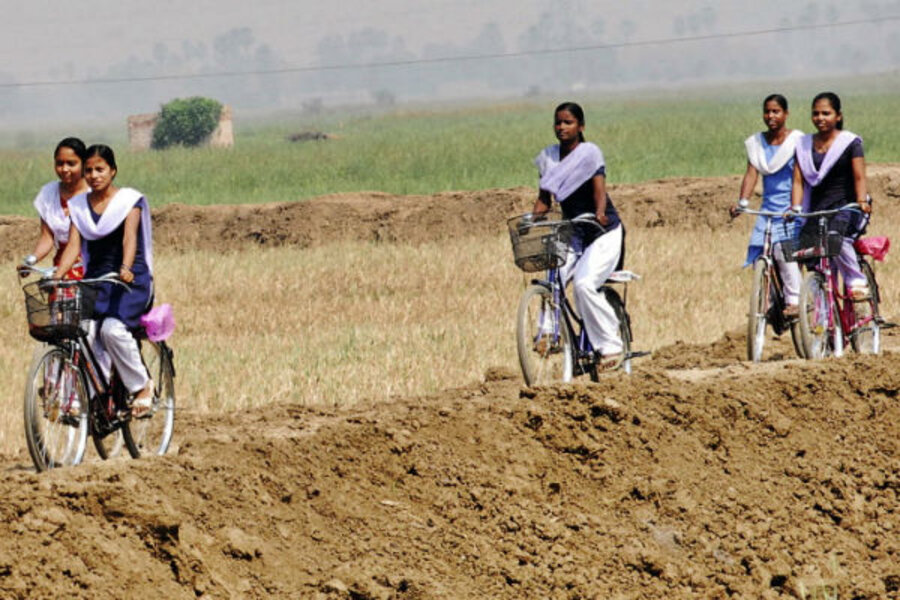Free bicycles help keep Indian girls in school
Loading...
| RAMPUR SINGHARA, India
The daily trip to high school was expensive, long and eventually, too much for Indian teenager Nahid Farzana, who decided she was going to drop out. Then, the state government gave her a bicycle.
Two years later, she is about to graduate from high school and wants to be a teacher.
The eastern state of Bihar has been so successful at keeping teenage girls in school, the bike giveaways have spread to neighboring states. Now the Indian government wants to expand it across the country in hopes it might help improve female literacy.
Before starting the program in 2007, officials in Bihar, one of India's poorest and least developed states, despaired over how to educate the state's females, whose literacy rate of 53 percent is more than 20 points below that of its males.
"We found that the high school dropout rate soared when girls reached the ninth grade. This was primarily because there are fewer high schools and girls had to travel longer distances to get to school," said Anjani Kumar Singh, Bihar's principal secretary overseeing education.
Poor families could not spare the money for transport, or were reluctant to let girls travel so far away, fearing for their safety.
The program was an instant success, with the number of girls registered in the ninth grade in Bihar's state schools more than tripling in four years, from 175,000 to 600,000.
"The results are remarkable. The school dropout rate for girls has plunged," says Singh.
In her crisply starched blue tunic uniform and white scarf, Farzana appears a carefree teenager, proud to have made it into the tenth grade. But she almost did not make it.
Her daily bus fare of 15 rupees (22 cents) to the new high school 6 kilometers (4 miles) from their home in Rampur Singhara village was an additional burden her father, a car mechanic, could not afford.
"I wouldn't have been able to keep Farzana in school for long," said Mohammed Shiraz Ahmad, her father.
A teacher told them about the free bicycles, and Farzana applied for the 2,500 rupee ($50) grant to buy the bike.
"The bicycle has changed everything," Ahmad said.
In remote villages, along dusty potholed lanes surrounded by sheaves of waving wheat, gaggles of school girls can be seen jauntily cycling to school.
The program has also raised the status of girls, who are often seen as a burden in son-obsessed India, where parents have to pay such hefty dowries to marry off their daughters that the family is often indebted for decades.
Now, girls are bringing an asset to the family, Singh said.
Mohammed Jalaluddin, who runs a tea stall in Rampur Singhara, says his daughter's bike is used by the entire family.
Nizhat Parveen, his 16-year-old daughter, drops her brother at his school on the way to hers. When she returns, the family uses the bicycle for chores, from shopping for groceries to making food deliveries from the tea shop.
Bihar is also giving free school uniforms to girls to keep them in school. The bike grant money is put into a joint bank account in the names of the student and her parents, and school administrators monitor whether the girls buy bicycles and use them, or if the bike is sold and the girl ends up leaving school, Singh said. But mostly, the program operates on the honor system.
While corruption and fraudulent use of state money is rife in India, the Bihar government reports misuse of the bicycle funds is 1 percent.
The results from Bihar were so encouraging that the program has been adopted by the neighboring states of Madhya Pradesh and Chhattisgarh. Rajasthan, another state with low female literacy rates, has launched a free bicycle program for girls in secondary and high school.
The federal government is exploring a plan to give bicycles to Muslim girls as their dropout rate is worse than that of other communities.
The bicycle program "has worked very well," says Syeda Hameed, a member of India's powerful Planning Commission body.
Hameed said the body is also looking at other factors that affect school attendance by girls in the higher classes, such as the lack of toilets in schools.
In poor families, older girls also leave school to take care of younger siblings while parents work. "This is a persistent problem which tends to push up dropout rates and is a matter of concern," Hameed said.
But with the bicycle program gaining in popularity, authorities are tightening conditions, demanding students have 75 percent attendance to "earn" their uniforms and the bicycle.
For high school student Parveen, her proudest possession, the free bicycle, has allowed her to dream of even greater things.
"Even college doesn't seem far away now," she says.





